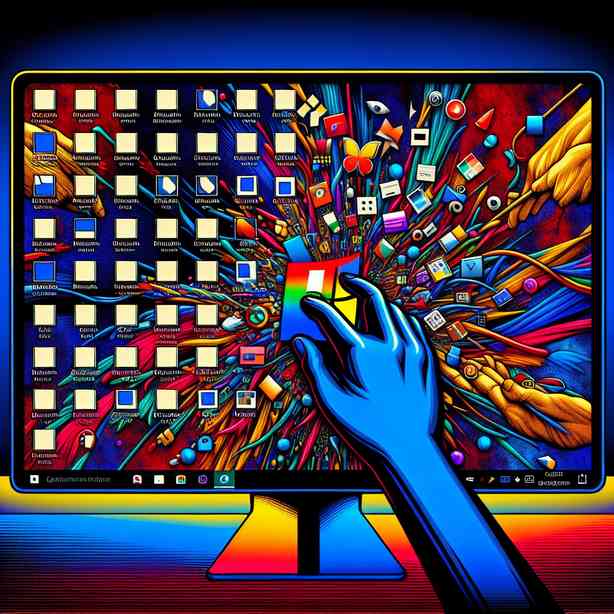
When the Taskbar Refuses to Hide
The taskbar is an essential component of the Windows operating system, providing quick access to your applications, notifications, and system settings. However, there are times when you might find that the taskbar refuses to hide, even when you have enabled the auto-hide feature. This issue can be frustrating, especially when you’re attempting to maximize your screen real estate for activities such as gaming, video editing, or multitasking. In this discussion, we will delve into the various reasons why the taskbar may refuse to hide and present you with effective solutions to resolve this persistent problem.
First and foremost, it is crucial to understand how the auto-hide feature for the taskbar works. This feature allows the taskbar to disappear from view when it is not in use, reappearing only when you move your cursor to the bottom edge of the screen. If this feature isn’t functioning as intended, it can be due to several factors including application settings, system processes that are active, or even third-party software that could be interfering. Identifying the root cause will greatly assist in troubleshooting the issue effectively.
One common reason the taskbar fails to hide is the presence of active applications. Certain programs may keep the taskbar visible by not allowing it to minimize, especially those that require user interaction or display notifications. For instance, if you have a messaging app or any communication tool open, it may keep the taskbar pinned open to alert you to new messages. To see if an active application is causing this, you can minimize or close all open applications to determine if the taskbar hides successfully.
Another potential culprit is the settings within Windows itself. Sometimes, the auto-hide feature may become disabled due to a system glitch or a recent update. To ensure that the auto-hide setting is enabled, you can follow these steps. Right-click on the taskbar, then select ‘Taskbar settings.’ Under the ‘Taskbar behaviors’ section, check the box that says ‘Automatically hide the taskbar.’ If this option is already checked, try toggling it off and then back on again, as this can sometimes resolve minor configuration issues with the system.
In addition to application settings and Windows configurations, the taskbar’s functionality can be affected by running processes that interfere with its ability to auto-hide. Certain background applications and services may prevent the taskbar from hiding properly when they are active. To investigate this, you can open the Task Manager by pressing Ctrl + Shift + Esc. Here, review the list of processes that are running in the background. If you identify any applications that you suspect might be causing the issue, consider closing them temporarily to see if it resolves the problem.
Moreover, one could also consider whether the taskbar is being obstructed by pop-up notifications. Windows routinely sends out notifications from apps, and even if you’re not currently interacting with these apps, their notifications may keep the taskbar engaged. You can manage your notification settings by going to Settings > System > Notifications & actions. Here you can toggle off notifications for specific apps that you find particularly intrusive and likely responsible for the taskbar’s behavior.
It’s also worth mentioning that desktop background elements might play a role in this scenario. If you have particular gadgets or widgets, they could potentially affect the visibility of the taskbar. Try disabling any such elements, especially those created by third-party applications, to see if they are impeding the functionality of the taskbar.
In the case that the above steps do not yield results, consider investigating whether there are any updates available for your Windows operating system. Microsoft frequently releases updates that address various bugs and performance issues, including those that might affect the taskbar. Navigate to Settings > Update & Security > Windows Update, and ensure that your system is up to date. After applying any available updates, restart your computer to see if the taskbar behavior has improved.
If the taskbar continues to resist hiding, doing a system file check might be the next logical step. You can use the System File Checker tool by running the ‘sfc /scannow’ command in the Command Prompt. This tool scans for corrupt system files that may be causing problems with your Windows installation, including issues with the taskbar.
In certain circumstances, it may also be beneficial to examine your display settings. If you are using multiple monitors, the taskbar might not behave in the way you expect due to how it is configured across different screens. Ensure that your display settings are properly adjusted and consider whether the taskbar is set to show on all displays or just the primary display.
Finally, if you have exhausted all other troubleshooting methods and the issue persists, consider creating a new user profile. Sometimes corruption in user profiles can lead to a variety of strange behaviors in Windows. By setting up a new user account, you can determine whether the problem is tied to your current profile or is a system-wide issue.
In conclusion, when the taskbar refuses to hide, it can be quite an inconvenience, disrupting your workflow and distracting from your tasks. By understanding the various causes behind this issue—ranging from active applications and Windows settings to running processes and notification management—you can more effectively troubleshoot and resolve the problem. Remember to check for updates, utilize system tools like the Task Manager and System File Checker, and explore adjustments to your display settings as a means to tackle this frustrating situation. As technology progresses and systems evolve, staying informed about these troubleshooting methods will help ensure a smoother computing experience.


